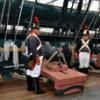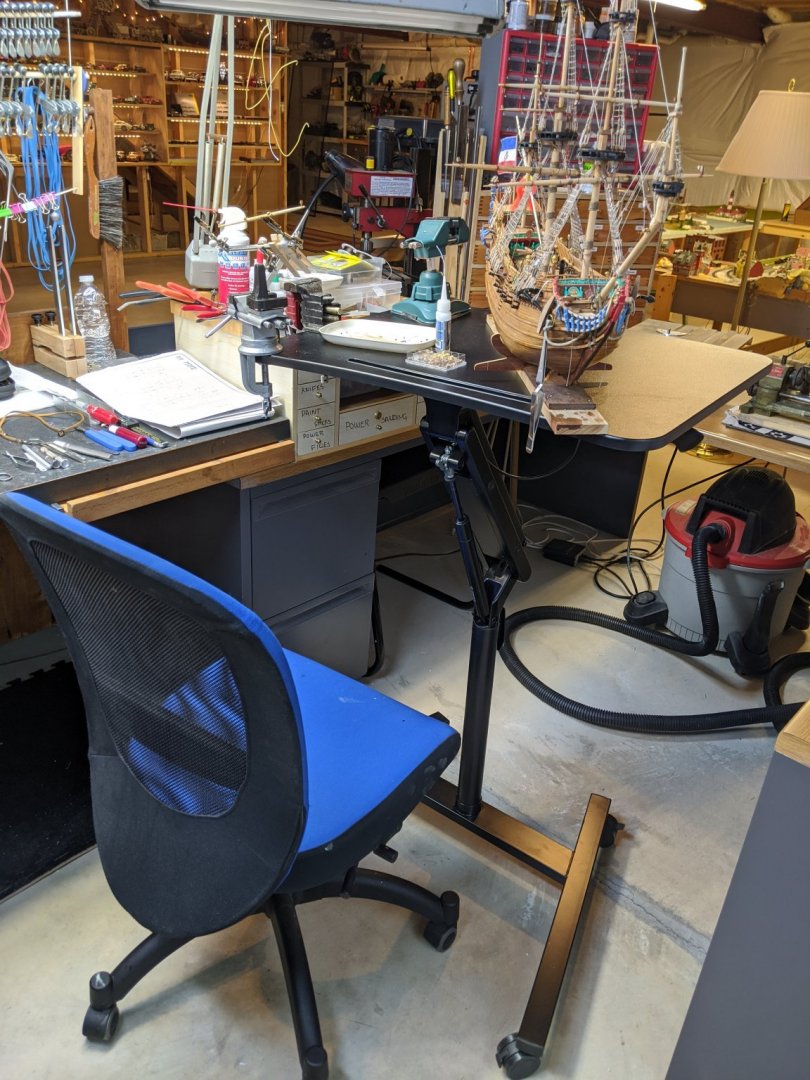-
Posts
1,933 -
Joined
-
Last visited
Content Type
Profiles
Forums
Gallery
Events
Posts posted by popeye2sea
-
-
My thinking on this is that the tarring of the standing rigging is to try and keep most of the wet out.
Since the anchor cable will be immersed when in use and completely water logged the tarring would just as effectively keep all the wet in and the cable would never dry out and eventually rot.
Of course....I may be totally wrong. 😉
Regards,
-
Unless I am mistaken, the only cannon that had that type of tail were the "murdering pieces" that were likely mounted in yokes on the rails of ships. Very small pieces, indeed. These were anti personnel weapons loaded with grape shot or langrange, that could be turned against boarders. The bent tail was essentially the handle used to aim the gun.
The guns provided in your kit seem to have combined the cascabel and the handle into one overly large piece.
Regards,
-
I use the Optivisor with glass lenses. The only problem I have with this set up has more to do with my prescription. I wear contact lenses with one eye corrected for far vision and the other corrected for near. I believe they call that monovision correction. It is an alternative to wearing bifocals. Anyway, because of that when working with the optivisor, which changes the focal distance, any length of time working is headache inducing due to eye strain.
I need to come up with a better solution.
Regards,
- mtaylor, DaveBaxt and thibaultron
-
 3
3
-
1 hour ago, wefalck said:
Actually, I cannot think of too many places, where one would splice a rope directly into an eye-bolt like this on a prototype. When such eye-bolts came into use, at the same time shackles and metal thimbles in eye-splices also came into use. Or hooks were used to connect the eye-splices to the eye-bolts.
I agree. The only places I can think of are sheets or braces for the lower yards/courses which sometimes were seized into ring bolts in the ships sides.
In any case, for any line spliced into an eye bolt, that will be the standing or fixed end of the line. You will probably have a tackle on the other end to set the line up taut. No need to do any fiddling or adjusting for length at the eyebolt end.
Go ahead and splice the line off the model and then insert the eyebolt into the hole.
Regards,
-
4 hours ago, Morgan said:
That a lower studding sail boom, not a spare yard.
Gary
That is correct. The lower stu'ns'l boom has a gooseneck hook in the forward end which sets into and pivots in an eyebolt on the fore end of the channel. The boom is swung out and guyed in position to spread the foot of the fore course stu'ns'l.
Regards,
- mtaylor and flying_dutchman2
-
 1
1
-
 1
1
-
What you have there is called marling. It would be used to gasket the furled sail to the yard.
The problem with using that to bend on a sail is that if one piece parted the whole sail would blow out because the whole thing is one piece of rope with a series of half hitches.
You would need to have the individual robands as shown in your lower diagrams in order to properly bend on a sail. The proper roband hitch varied across time and also when utilized on an upper or lower yard.
Regards,
-
Trade winds.
They are called trade winds because they predominantly blow from the one direction, thus making it easier to establish cheaper trade routes. Square sails generate more power than fore and aft sails. Once you set and trim your square sails for the trade wind you shouldn't have to re trim. Saves time and money.
Regards,
-
I think you could accomplish making a framework of the sail from the bolt rope only, but, just trying to think it through, you would have a problem with the bolt ropes sagging inward or outward when you put tension on the corners of the sails via the rigging. Perhaps if you used wire instead of rope for the bolt rope?
Regards,
-
-
May not have been for charts. Could be for flags.
Regards,
- mtaylor, Keith Black, GrandpaPhil and 1 other
-
 4
4
-
1 hour ago, tedrobinson2000 said:
How about another anomaly? Both Caldercraft and in McKay’s AOS, the fore top yard braces are shown to be belayed in the waist on the second skid beam of the boat tier, in between the boats. This seems not to be very efficient in that a sailor would have had to climb over and between the stowed boats to even reach this point, and then would have had no room to haul on the line, much less having room for the other dozen or so hands needed to haul. Seems like the top yard braces would have been in constant need of adjustment, especially when tacking. There must have been a better way to belay these lines. Any ideas?
I agree. A brace (or any other line) would never have been belayed to a boat skid beam.
Regards,
-
-
I have never been able to get an answer to the same question regarding stowage of jeer or halyard lines.
4 hours ago, tedrobinson2000 said:As to the stowage of the jeer falls, I again note that each would have been about 250’ long with the yard raised, and were 7-1/2” lines. Popeye, as to making hanks and hanging the excess on the falls, it may do for smaller ships, but 250’ of 7-1/2” line seems way too much line to have been done this way on a first rate. It seems easier to send the unused line below, through the gratings, to the upper gun deck for stowage. I believe, that once the lower yards were hauled up, probably at the shipyard at first, they were not lowered again very often, if ever. The upper yards were frequently raised and lowered to shorten the top and topgallant sails, but I doubt if the course yards were moved very often.
Yes, that is true for ships from the late 17th century on. But the same conundrum would occur for earlier periods where the lower yards were shifted much more frequently and consequently the halyards were probably left rigged. Would you then have a very large coil on the gun decks fouling the cannons or capstans? Would you lead the bitter end down to the cable tier for coiling?
Again, I have no answer.
Regards,
-
For belaying line directly to a rail a clove hitch will work just fine.
I don't know how accurate it is, but I have seen on modern replica ships like L'Hermione that the jeer falls were made up with long hanks into a gasket coil and hitched vertically to the falls so that they hang abaft the mast.
Regards
-
-
Something like a sheer hulk. Except this one is still able to sail.
Regards,
- Thanasis, mtaylor and thibaultron
-
 3
3
-
It's not clear from your question what parts you are referring to. Are you asking how to attach the strop of a block to a mast band or are you asking how to attach a line coming from the block? The strop is the rope that passes around a block and allows the block to be suspended from a fitting or spar.
Not sure where you are referring to, but blocks would not normally be attached directly to a mast band. There would have been an eye bolted through or into the band. In which case the eye of the block would be seized to the eye on the band. The seizing would take the form of a lashing between the two eyes. If the block was stropped with a hook, then the hook would be hooked into the eye on the band.
Another method for attaching a block to a mast would be to have a long strop with eyes on both legs of the strop. The legs were passed around the mast and the eyes lashed together on the opposite side with a rose lashing.
Regards,
-
Perhaps the rigging diagram has just omitted the tackle for the other pendant for clarity. It is often the case that rigging plans only show one side and you just assume the duplication on the other side.
The function of the truss, or parrels was to confine the yard in to the mast. Slacking the truss would allow you to either brace the yard hard around or allow the yard to come away from the mast for lowering.
Regards,
-
It seems to have a very large tackle seized to it. So my guess would be a cargo boom.
Regards,
- Thanasis, mtaylor and thibaultron
-
 3
3
-
14 hours ago, allanyed said:
I am having a hard time picturing this as the lower yards on the USS Constitution were nearly triple the length of the channels. I did some searching on my own but could not find anything contemporary.
I am not at all certain that spares were carried for the course yards. If one of those were carried away your ship was in deep sh t.
Spares for the topgallant and royals could be carried lashed vertically to either the topmast or lower shrouds.
Regards,
-
-
-
On 7/22/2021 at 6:37 PM, Gregory said:
Without sails, I think braces and lifts make for a clean look.
Braces and lifts are not sail rigging, so they would be there regardless. Even if you do not wish to include lines for the sails like the sheets and clews, bow lines and leech lines, the blocks on the yard would have stayed in place even after unreeving the lines.
Just in case you were not aware, in your rigging diagram above, the lines in red are the braces and lifts. They will stay rigged with or without sails.
Regards,
-
Beautiful work as always. The color scheme is really coming together.
Regards,
- Hubac's Historian, druxey, EJ_L and 1 other
-
 4
4




Horses ( Footropes )
in Masting, rigging and sails
Posted
The illustration is of man ropes. They are a sort of hand hold for going out on the bowsprit. Lees has his nomenclature wrong.
There is no need for footropes under the bowsprit. Footropes would more properly be found under the spritsail yard.
Regards,